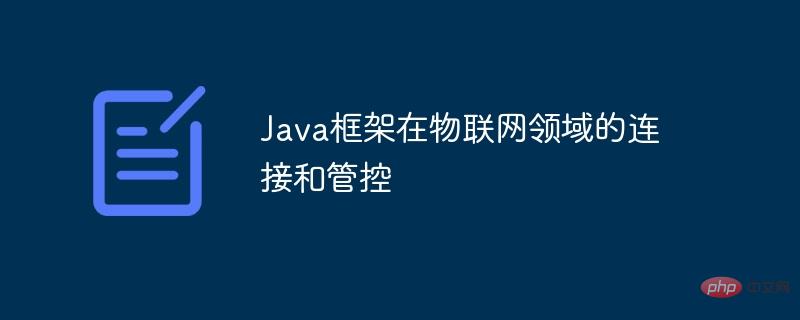Home >Java >javaTutorial >Connection and control of Java framework in the field of Internet of Things
Connection and control of Java framework in the field of Internet of Things
- WBOYWBOYWBOYWBOYWBOYWBOYWBOYWBOYWBOYWBOYWBOYWBOYWBOriginal
- 2024-06-02 20:51:001169browse
Java framework plays an important role in the field of Internet of Things, providing connection and management support. In terms of connectivity, MQTT and RESTful API are commonly used protocols and can be implemented through Java libraries. In terms of management and control, CoAP and LwM2M protocols provide device management and remote control functions for different application scenarios.

Connection and control of Java framework in the field of Internet of Things
Introduction:
Internet of Things The rapid development of mobile Internet has put forward higher requirements for device connection and management. With its power and flexibility, Java framework has become one of the preferred tools for building IoT solutions.
Connection:
- MQTT (Message Queuing Telemetry Transport): Based on the publish/subscribe model to implement low-power devices and the cloud platform communications. The Java library includes the Paho MQTT Java client.
- RESTful API: Uses the HTTP protocol, allowing the client to send requests to the server and receive responses. Java frameworks such as Jersey and Spring REST can simplify API development.
Practical case:
Use Paho MQTT Java client and Spring Boot framework to build a simple sensor connection system:
@SpringBootApplication
public class MqttApplication {
public static void main(String[] args) {
SpringApplication.run(MqttApplication.class, args);
}
@Bean
public MqttPahoClientFactory mqttPahoClientFactory() {
DefaultMqttPahoClientFactory factory = new DefaultMqttPahoClientFactory();
factory.setConnectionTimeout(10);
factory.setServerURIs(new String[] {"tcp://localhost:1883"});
return factory;
}
@Bean
public MqttClient mqttClient(MqttPahoClientFactory factory) {
MqttConnectOptions options = new MqttConnectOptions();
options.setCleanSession(true);
return factory.createClient(options);
}
}Control :
- CoAP (Constrained Application Protocol): Lightweight protocol for resource-constrained devices, supporting device management and remote control. Java libraries include Eclipse Californium.
- LwM2M (Lightweight Machine to Machine): A protocol for IoT devices, providing a standardized device management mechanism. Java frameworks include Eclipse Leshan.
Practical case:
Use LwM2M protocol to manage connected devices:
public class Lwm2mServerApplication {
public static void main(String[] args) {
Lwm2mServer server = new Lwm2mServer();
server.setHost("localhost");
server.setPort(5683);
server.start();
}
}Conclusion:
Through Java framework, Developers can easily build scalable and reliable IoT solutions for device connectivity and management needs.
The above is the detailed content of Connection and control of Java framework in the field of Internet of Things. For more information, please follow other related articles on the PHP Chinese website!
Related articles
See more- Which service is used for swoole Internet of Things development?
- The Internet of Things is a multi-dollar Internet
- What is the core and foundation of the Internet of Things
- How to Design a Scalable Java Framework: Experience and Advice
- How to conduct security testing in Java framework security architecture design?

